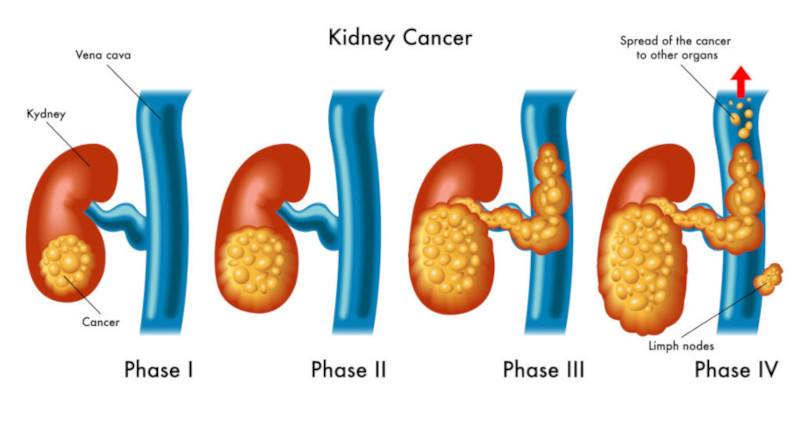Treatment Kidney Cancer
Whenever possible, we will remove the tumor while preserving the kidney.
We have all the technology available to treat kidney cancer, such as the DaVinci robot, laparoscopy and ablative treatments, among others.
- Super-specialized urologists
- Personalized treatment
- Minimally invasive approach
- More than 16,000 patients successfully treated
Kidney cancer treatments
The treatment of renal cancer will depend on the stage of the cancer, the patient's age and other health problems he/she may have. Whenever technically and oncologically possible, an attempt will be made to remove only the tumor while preserving the kidney.
For treatment, it is necessary to differentiate between localized and metastatic tumor:

Treatment of localized tumors:
Partial nephrectomy or nephron-sparing surgery:
It is the recommended treatment in patients whose disease is in stage I. It consists of removing the entire renal tumor, preserving as much of the organ as possible to avoid subsequent renal failure, that is to say, only the tumor is removed and the rest of the healthy renal tissue is preserved.
This treatment achieves 80-100% disease-free survival rates at 5 years. This is the most appropriate treatment, whenever technically possible, in tumors smaller than 7cm, in patients with tumors in both kidneys or in patients with only one kidney. Surgery can be performed by open, laparoscopic or robotic approach, depending on the characteristics of the case.
Robotic surgery in the treatment of localized renal cancer by means of partial nephrectomy allows to approach tumors of any complexity through a minimally invasive technique of high precision and excellent oncological result, adding a faster recovery, lower risk of bleeding, less postoperative pain and shorter hospital stay. At ROC Clinic we have the two robotic systems available in the market: Da Vinci and Hugo RAS.
Radical nephrectomy:
This is the recommended treatment in patients in whom partial surgery is not possible. It consists of the total removal of the affected kidney respecting the adrenal gland, unless this is infiltrated by the tumor. In cases where the lymph nodes have been found to be affected, lymphadenectomy (removal of the lymph nodes close to the kidney) will be performed. Radical nephrectomy can also be performed by open, laparoscopic or robotic approach, depending on the characteristics of each case.
Active surveillance:
Sometimes surgery may not be the best option for you. Both in very elderly patients, as well as in those who are in poor health or who have tumors smaller than 3-4 cm, close surveillance of the tumor can be performed.
During this active surveillance period, periodic visits with imaging tests will be scheduled. To determine if active surveillance is an option and to properly refine the individualized diagnosis, your urologist may recommend a biopsy of the kidney tumor. If tests performed during active surveillance show that the tumor is growing rapidly, or if you develop symptoms that may indicate that the disease is progressing, the urologist will immediately plan salvage treatment, primarily based on surgery.
Ablative therapies:
In people who are not suitable for surgery because it poses a significant risk, either because they are at a very advanced age or because they suffer from other diseases, kidney cancer can be treated by ablation. This procedure applies energy to the tumor laparoscopically or percutaneously by means of radiofrequency or cryotherapy. It can also be performed in people with tumors smaller than 3 cm in certain locations.
Treatment of locally advanced or metastatic tumors:
Nephrectomy of renal tumor with cava thrombus:
When the tumor progresses locally, thrombus with a tumor component may appear in the renal vein, or even in the vena cava. In these cases, it is necessary to perform nephrectomy and exeresis (removal) of the entire tumor thrombus, sometimes requiring the collaboration of cardiac surgeons.
Cytoreductive nephrectomy combined with systemic therapies:
It is performed in cases of metastatic renal tumor, that is, when the renal cancer spreads to other organs or lymph nodes. In metastatic disease, the renal tumor is called the primary tumor and secondary tumors in other organs are called metastases. When this happens, a cytoreductive nephrectomy is performed with the intention of curing the patient or prolonging his survival, combining surgery with systemic therapies (immunotherapy, antiangiogenics). It consists of removing as much of the tumor as possible in order to increase the chances of success in immunotherapy treatments and other targeted drugs. This removal also makes it possible to eliminate surrounding tissue that may contain cancerous cells.
Systemic therapies:
Chemotherapy is of little use in the treatment of kidney tumor. However, immunotherapy and drugs aimed at activating the immune system help to attack the cancer cells and achieve great survival benefits. Immunotherapy can cause side effects, depending on the drug, which usually disappear at the end of treatment: tiredness, stomach upset, fever, chills and skin rashes.
Once any of these treatments have been completed, it is important to have periodic check-ups to follow up with diagnostic tests.
They ask us in the Consultation
How do you know if a cyst in the kidney is malignant?
To know if a kidney cyst is malignant, it is important to perform a series of studies and medical evaluations. The most common steps to determine the nature of a kidney cyst are: Renal ultrasound: ultrasound can show the shape and size of the cyst, as well as the presence of any suspicious features, such as irregular walls or inhomogeneous fluid. Computed tomography (CT): If the cyst has suspicious features on ultrasound, a CT scan may be done to obtain more detailed images. This helps to identify if there are solid masses within the cyst or changes in the cyst walls that suggest malignancy. Magnetic resonance imaging (MRI): is useful to better characterize the cyst and may provide additional information about its composition. This is particularly useful if there is doubt after the CT scan. Bosniak classification: The Bosniak classification system is used to categorize renal cysts based on their appearance on imaging and help determine the risk of malignancy. Biopsy: In some cases, if the cyst is suspected to be malignant or if imaging tests are inconclusive, a renal biopsy may be performed to obtain a sample of the tissue and examine it under the microscope. In general, benign kidney cysts do not cause symptoms. However, if a cyst becomes large, it may cause pain in the back or abdomen. If the cyst is malignant, there may be additional symptoms such as blood in the urine, unexplained weight loss or fatigue.
What is the prognosis of kidney cancer?
In general, in patients with renal tumors under 4 cm that are treated surgically, cure rates of over 90% are achieved. If the mass is large and has spread outside the kidney, the prognosis is worse, especially if any of the following factors are present: anemia, high lactate dehydrogenase level, high blood calcium level, spread to two or more distant sites, or if the person's general condition is unfavorable.
Is kidney cancer curable?
Kidney cancer is curable in early stages. It is key that, once kidney cancer is treated, the patient is followed closely. In advanced stages of the tumor, surgery can help palliate symptoms and, in selected patients, can be combined with other treatments such as chemotherapy or immunotherapy to improve survival and quality of life.
What is the best treatment for kidney cancer?
Surgery is the standard treatment, achieving cure rates of over 90% in small tumors. There are various types of surgery depending on the size of the tumor, but whenever possible, the aim is to remove only the tumor, preserving the rest of the kidney and renal function.
Team of the Kidney Cancer Unit
Newsof ROC Clinic in Kidney Cancer
Research
Da Vinci and Hugo RAS Platforms for robot-assisted partial nephrectomy: a preliminary prospective comparative analysis of the outcomes.


 +34 912 627 104
+34 912 627 104 Contact
Contact











